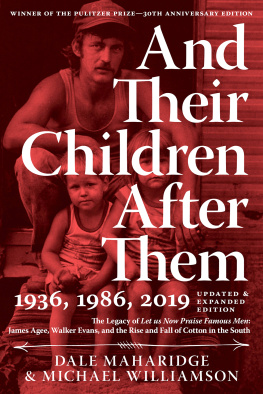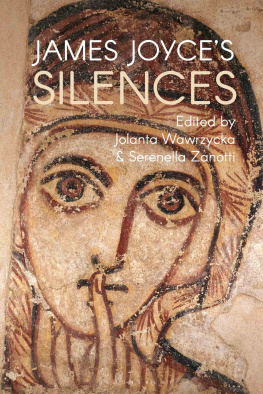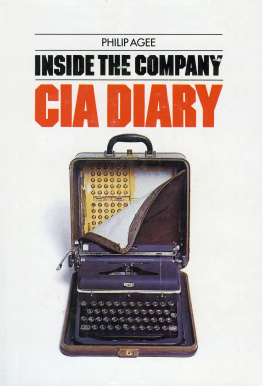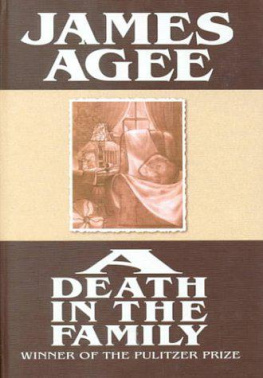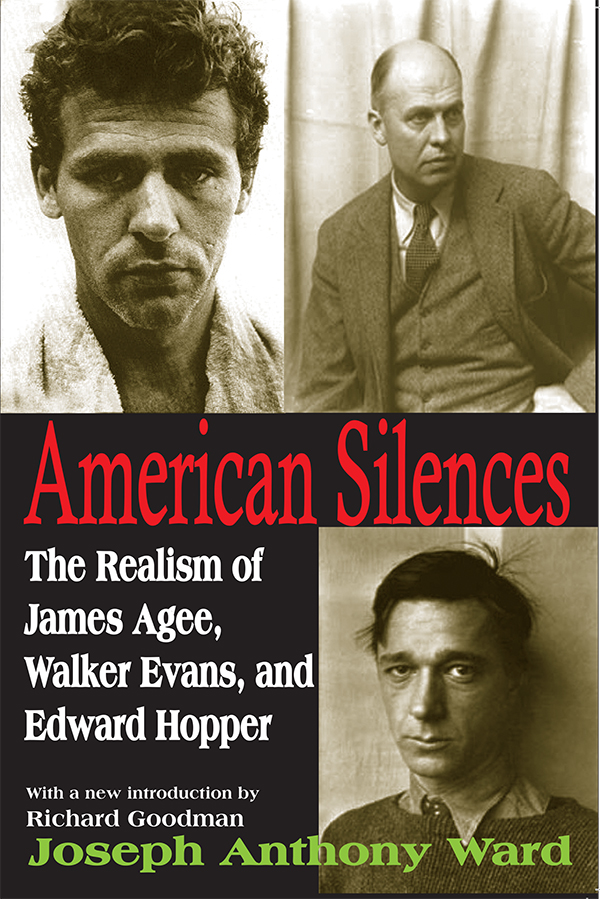Contents
Originally published in 1985 by Louisiana State Press
Published 2010 by Transaction Publishers
Published 2017 by Routledge
2 Park Square, Milton Park, Abingdon, Oxon OX14 4RN
711 Third Avenue, New York, NY 10017, USA
Routledge is an imprint of the Taylor & Francis Group, an in forma business
Copyright 2010 by Taylor & Francis.
All rights reserved. No part of this book may be reprinted or reproduced or utilised in any form or by any electronic, mechanical, or other means, now known or hereafter invented, including photocopying and recording, or in any information storage or retrieval system, without permission in writing from the publishers.
Notice:
Product or corporate names may be trademarks or registered trademarks, and are used only for identification and explanation without intent to infringe.
Library of Congress Catalog Number: 2010018131
Library of Congress Cataloging-in-Publication Data
Ward, J. A. (Joseph Anthony), 1931
American silences : the realism of James Agee, Walker Evans, and Edward Hopper / Joseph Anthony Ward.
p. cm.
Originally published: [Baton Rouge] : Louisiana State University Press, 1985. With new introd.
Includes bibliographical references and index.
ISBN 978-1-4128-1097-5 (alk. paper)
1. Realism in art--United States. 2. Art, American--20th century. 3. Agee, James, 1909-1955--Criticism and interpretation. 4. Evans, Walker, 1903-1975 1955--Criticism and interpretation. 5. Hopper, Edward, 1882-1967 1955--Criticism and interpretation. I. Title. II. Title: Realism of James Agee, Walker Evans, and Edward Hopper.
N6512.5.R4W37 2010
700.973--dc22
2010018131
ISBN 13: 978-1-4128-1097-5 (pbk)
Contents
TO MARGARET AND ELIZABETH
We live in an age in which the impact of materialized forces is well-nigh irresistible; the spiritual nature is overwhelmed by the shock. The tremendous and complicated development of our material civilization, the multiplicity and variety of our social forms, the depth, subtlety, and sophistry of our imaginative impressions, gathered, re-multiplied, and disseminated by such agencies as the railroad, the express and the post-office, the telephone, the telegraph, the newspaper, and in short, the whole machinery of social intercoursethese elements of existence combine to produce what may be termed a kaleidoscopic glitter, a dazzling and confusing phantasmagoria of life that wearies and stultifies the mental and moral nature. It induces a sort of intellectual fatigue through which we see the ranks of the victims of insomnia, melancholia, and insanity constantly recruited.
THEODORE DREISER
Jennie Gerhardt
Leisure is a form of silence, of that silence which is the prerequisite of the apprehension of reality: only the silent hear and those who do not remain silent do not hear. Silence, as it is used in this context, does not mean dumbness or noiselessness; it means more nearly that the souls power to answer to the reality of the world is left undisturbed.
JOSEF PIEPER
Leisure: The Basis of Culture
The author is grateful for permission to reprint the following, which appear here in slightly different form as parts of : Silence, Realism, and The Great Good Place, Henry James Review, III (Winter, 1982), copyright 1982 by the Henry lames Society, reprinted by permission; James Agees Aesthetic of Silence: Let Us Now Praise Famous Men, in Tulane Studies in English, copyright 1978 by Tulane University, New Orleans, reprinted by permission; and A Death in the Family: The Importance of Wordlessness, Modem Fiction Studies, XXVI (Winter, 198081), copyright 1980 by Purdue Research Foundation, West Lafayette, Indiana 47907, reprinted by permission.
Photographs by Walker Evans from American Photographs (New York, 1938) and Let Us Now Praise Famous Men (New York, 1969) are part of the Farm Security Administration Collection in the Prints and Photographs Division of the Library of Congress, Washington, D.C. 20540.
Reproductions of the Edward Hopper paintings used herein were published previously in Edward Hopper: The Art and the Artist (New York, 1980).
Illustrations
T HE TITLE OF THIS book is somewhat misleading. While American Silences: The Realism of James Agee, Walker Evans, and Edward Hopper by Joseph Anthony Ward, is, indeed, about these three artists, there is also a chapterthe second longest in the bookdevoted to Sherwood Anderson and to Ernest Hemingway, and another, the books first short chapter, devoted to Edgar Allan Poe, Herman Melville, Henry James, and Henry Adams. So, I take the heart and soul of American Silences to concern Anderson, Hemingway, Agee, Evans and Hopperthe order in which they appear in the book. The link is too strong among these artists. And the coupling too informative.
So, we have three writers, one photographer and one painter, and they are all of them distinctly American in a way that Melville, Poe, Adams, and, especially James, are not. Sherwood Anderson was raised in Clyde, Ohio; Ernest Hemingway in Oak Park, Illinois; James Agee grew up in Knoxville, Tennessee; Walker Evans was from St. Louis; and Edward Hopper was from Nyack, New York. Three Midwesterners, one Southerner, and the lone Easterner, as opposed to the all-Eastern contingent of Melville, Poe, Adams, and James. I think it no accident that our greatest writers in the first twenty or thirty years of the twentieth century were from the heart of the heart of the country. This would include Theodore Dreiser, who was from Indiana, and F. Scott Fitzgerald, who, regardless of his fascination with Eastern wealth, was still from Minnesota.
Its no accident, because the Midwest, and Agees mountainous South, were far from the gloss and worry of eastern cities and their desire to be like European capitals. The Midwest was, and is, straightforward, unadorned, plain, and simple. And certainly filled with silences. These qualities show clearly in the work of Anderson, Hemingway and Evans. And in Hopper, as well, who, save for his love of salt water landscapes, could have been from the Midwest. Agee has the baroque influence of a state where more battles were fought in the Civil War than any state other than Virginia. He was born a mere forty-six years after Union troops wrested the city of Knoxville from Confederate forces. You do not grow up in such an atmospherethe city would have had Confederate veterans stories for the boy Agee to listen towithout death and drama in your blood.
These men have had great influence on American artsave, I think, for Agee, who in this writers opinion is sui generis, one of a kind, and nearly inimitable. I would say that if any of his work has influenced generations that have followed, it would be his film criticism, and not his novels, and not Let Us Praise Famous Mena collaboration, as we know, with Walker Evanswhich is a tortured, rambling book. Ward calls it an irritating book. And in fact, Ward begins his chapter on Agee by quoting from his film criticism. But Anderson, Hemingway, Evans, and Hopperwhat marks they left, and how they influenced those that followed, and continue to do so.
William Faulkner called Sherwood Anderson, the father of us all, with Mark Twain being the grandfather. Anderson befriended Faulkner in New Orleans and offered to convince his publisher to take Faulkners first book, if, Anderson stipulated, I dont have to read it. Andersons fame rests mostly on his book of linked short stories,



